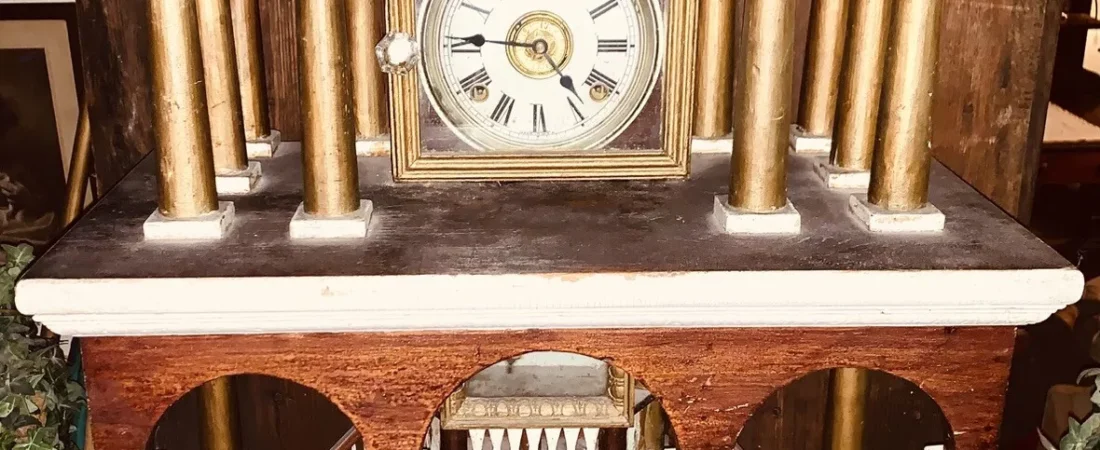In the realm of antique collecting, few objects capture the imagination quite like rare and exceptional timepieces. These mechanical marvels represent not only the pinnacle of craftsmanship from bygone eras but also serve as tangible connections to our horological heritage. As silent witnesses to history, antique clocks combine artistic beauty with mechanical ingenuity in a way that continues to captivate collectors and enthusiasts alike.
In this curated review, we explore some of the most extraordinary antique clocks available today. From ornate French mantel clocks to sophisticated English longcase masterpieces, each selection represents the highest echelon of horological art. Whether you’re a seasoned collector or an appreciative newcomer to the world of fine timepieces, these remarkable clocks offer both aesthetic pleasure and investment potential that transcends generations.
The Cartier Art Deco Jade Marvel: A Horological Triumph in Precious Materials
Within the rarefied world of luxury timepieces, few examples capture the essence of 1920s Art Deco splendor quite like this extraordinary Cartier desk clock. Crafted in Paris during the roaring twenties, this exceptional timepiece represents the pinnacle of Cartier’s artistry during one of the most influential design periods of the 20th century.
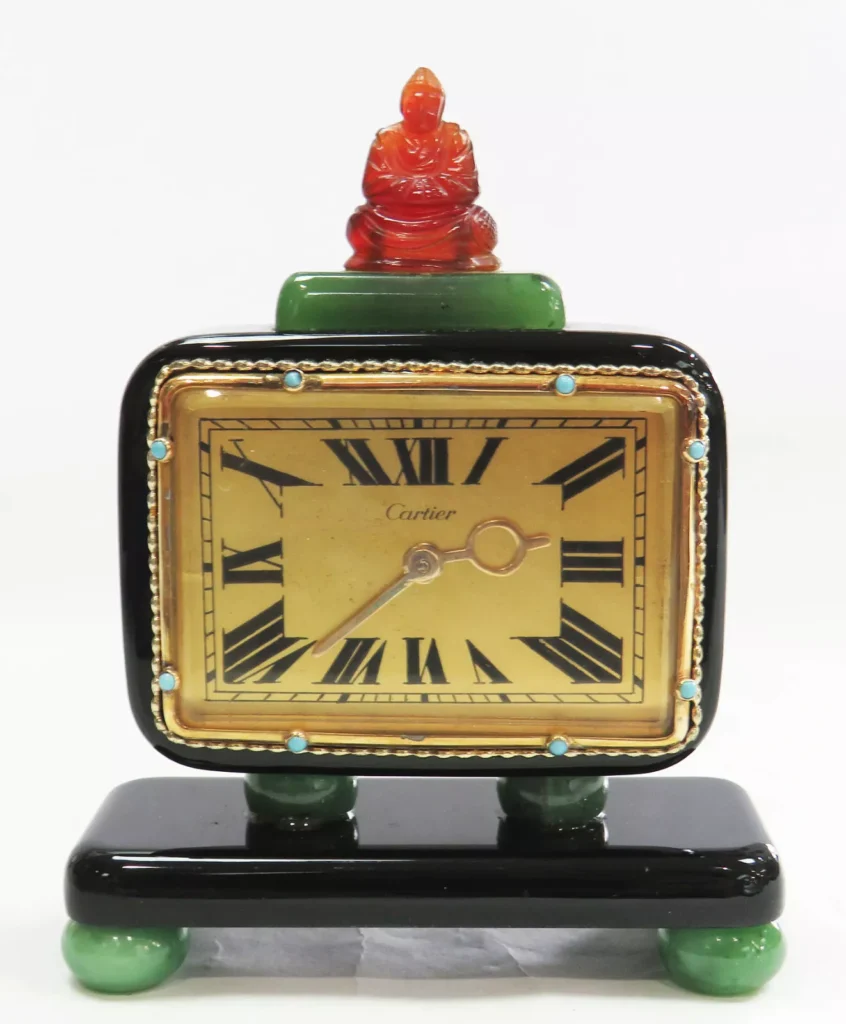
This remarkable clock stands as a testament to Cartier’s unparalleled craftsmanship and innovative vision. The masterful combination of red jade Buddha, vibrant green jade body, and sophisticated black onyx creates a striking color palette that immediately draws the eye. The meticulous integration of these precious materials speaks to the exceptional skill of Cartier’s artisans, who transformed raw gemstones into a functional work of art that has maintained its allure for over a century.
The elegant 18K gold bezel frames the clock face with timeless sophistication, while delicate turquoise buttons add subtle points of color that enhance the overall aesthetic without overwhelming the design. The gold clock hands move with the precision one expects from Cartier, demonstrating that this piece was created not merely as decorative art but as a functioning timepiece of the highest caliber.
Standing at 4¼ inches tall and 3½ inches across, this clock commands presence without dominating a space—a hallmark of thoughtful Art Deco design. Its compact yet substantial dimensions make it ideal for display on a desk, mantel, or within a curated cabinet of curiosities. The square shape, characteristic of Art Deco’s geometric preferences, provides a perfect canvas for the interplay of precious materials.
What elevates this clock beyond many comparable pieces is its authenticated provenance. The accompanying documentation from Cartier International Paris (through New York) detailing repairs and replacement of missing parts in 1997 not only confirms its authenticity but adds a layer of historical significance. This paper trail demonstrates both the value Cartier places on its heritage pieces and the ongoing care that such treasures deserve.
The seller’s assertion that this piece “belongs in a museum” is not mere hyperbole. Examples of this quality and provenance rarely appear on the private market, as many have already found their way into institutional collections. This clock represents a tangible connection to the artistic flowering that followed the First World War, when luxury houses like Cartier were redefining the boundaries between functional timepieces and decorative art.
For collectors of Art Deco objects, Cartier memorabilia, or fine clocks, this piece offers an exceptional opportunity. Its combination of precious materials—jade, onyx, turquoise, and 18K gold—ensures not only aesthetic pleasure but tangible investment value. Unlike many decorative objects that may fall victim to changing tastes, Cartier pieces from this era have consistently appreciated in value, making them sound investments as well as objects of beauty.
The Bim-Bam chime sequence adds another dimension of delight, transforming the simple act of timekeeping into a multisensory experience. This auditory element complements the visual splendor, creating a piece that engages more deeply than silent timepieces.
For those fortunate enough to acquire this clock, it would serve as the centerpiece of any collection, a conversation starter that bridges art, craftsmanship, and history. We invite serious collectors to consider this rare opportunity to own a piece of Cartier’s illustrious legacy—a timepiece that truly captures the spirit of an age when beauty and functionality achieved perfect harmony.
German Black Forest Masterpiece: The Dual Cuckoo Clock of Timeless Heritage
When discussing quintessential German craftsmanship, few objects embody the tradition, skill, and charm of the Black Forest cuckoo clock. This particular example, standing an impressive 21 inches tall and featuring dual cuckoo birds, represents a superb specimen from the early Edwardian era that carries with it not just timekeeping functionality, but a century of family history.
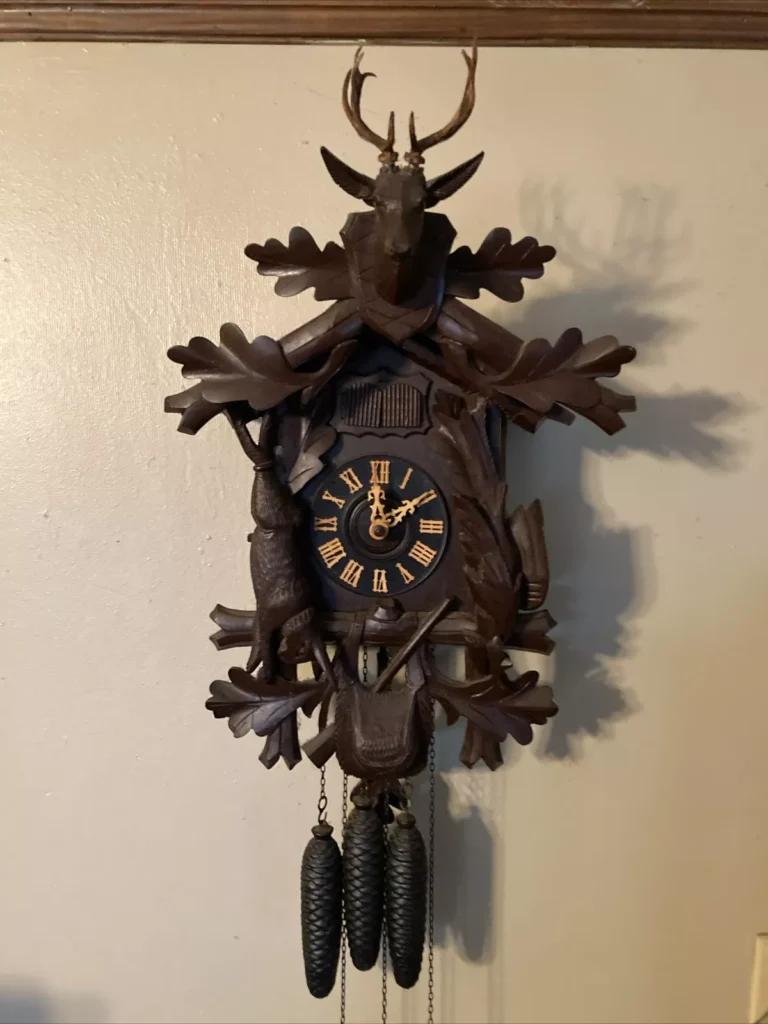
This magnificent Hunter-branded Black Forest cuckoo clock immediately captures attention with its imposing presence and distinctive silhouette. The natural wood finish showcases the exceptional carving work typical of German clockmaking traditions, with the ornate hunting-themed decorative elements providing a rich visual narrative that draws the eye across the piece. The majestic buck with intact antlers crowning the clock speaks to the hunting traditions of the Black Forest region, while the intricate detailing around the clock face demonstrates the painstaking attention to detail characteristic of German craftsmanship from this period.
What truly distinguishes this particular clock is its dual cuckoo bird mechanism – a rarer and more complex feature than the single-bird design found in many examples. Despite showing the expected signs of their century-long journey through time, including small chips and wear, the charming birds emerge faithfully to announce the hour, creating a delightful spectacle that connects viewers to generations past. The mechanical precision required to orchestrate this dual-bird performance underscores the technical prowess of Black Forest clockmakers at the turn of the 20th century.
The provenance of this clock adds immeasurable value to its already considerable charm. Having been passed down through three generations of the same family, this timepiece carries with it the whispered conversations, celebrated milestones, and quiet moments of daily life spanning an entire century. The “Made in Germany” stamp and hand-scratched markings inside the case provide tangible evidence of its authentic heritage, while the various signs of repair over the decades tell a story of an object cherished enough to warrant ongoing care and attention.
The clock’s musical chime sequence adds another dimension to its sensory appeal. Unlike simpler cuckoo clocks that offer only the distinctive call of the birds, this model provides melodic accompaniment that would have filled its original home with periodic moments of delight. The long chains, extending approximately 5½ feet, create a dramatic visual element that emphasizes the clock’s traditional hand-wound mechanism – a tactile ritual that connects the owner to clockkeeping traditions spanning centuries.
The textured black background of the clock face with its applied numerals represents an interesting aesthetic choice that distinguishes this piece from many contemporaries. This detail, along with other elements that appear to have been restored or replaced approximately 60 years ago, speaks to the evolutionary nature of cherished heirlooms. Rather than diminishing its value, these sympathetic interventions have ensured the clock’s continued functionality while respecting its original character.
For collectors of European timepieces, this clock represents an exceptional opportunity to acquire a genuine Black Forest cuckoo with documented family provenance spanning a century – a rarity in today’s market where questionable attributions and unclear histories often cloud the authenticity of purportedly antique pieces. The mechanical movement, now demonstrated to be in working order, promises many more years of faithful service with proper care and maintenance.
Beyond its function as a timekeeper, this cuckoo clock would serve as a magnificent focal point in a variety of interior settings. Whether integrated into a traditional European-inspired decor scheme, juxtaposed against more contemporary furnishings as a statement piece, or displayed within a dedicated collection of fine clocks, its imposing presence and charming performance would invariably draw admiration and spark conversation.
For those who value the intersection of mechanical ingenuity, traditional craftsmanship, and tangible history, this dual-cuckoo Black Forest clock represents not merely an acquisition but an adoption – taking on stewardship of a piece that has already faithfully served generations and stands ready to delight many more to come.
Horological Jewelry Marvel: 1860s Gold Miniature Clock Pendant with Blue Enamel Artistry
The intersection of fine jewelry and precision horology reaches its zenith in this extraordinary c.1860 miniature keywind pendant clock. This remarkable piece embodies the Victorian fascination with technical sophistication and decorative luxury, creating a wearable timepiece that transcends mere functionality to become a true object of art.
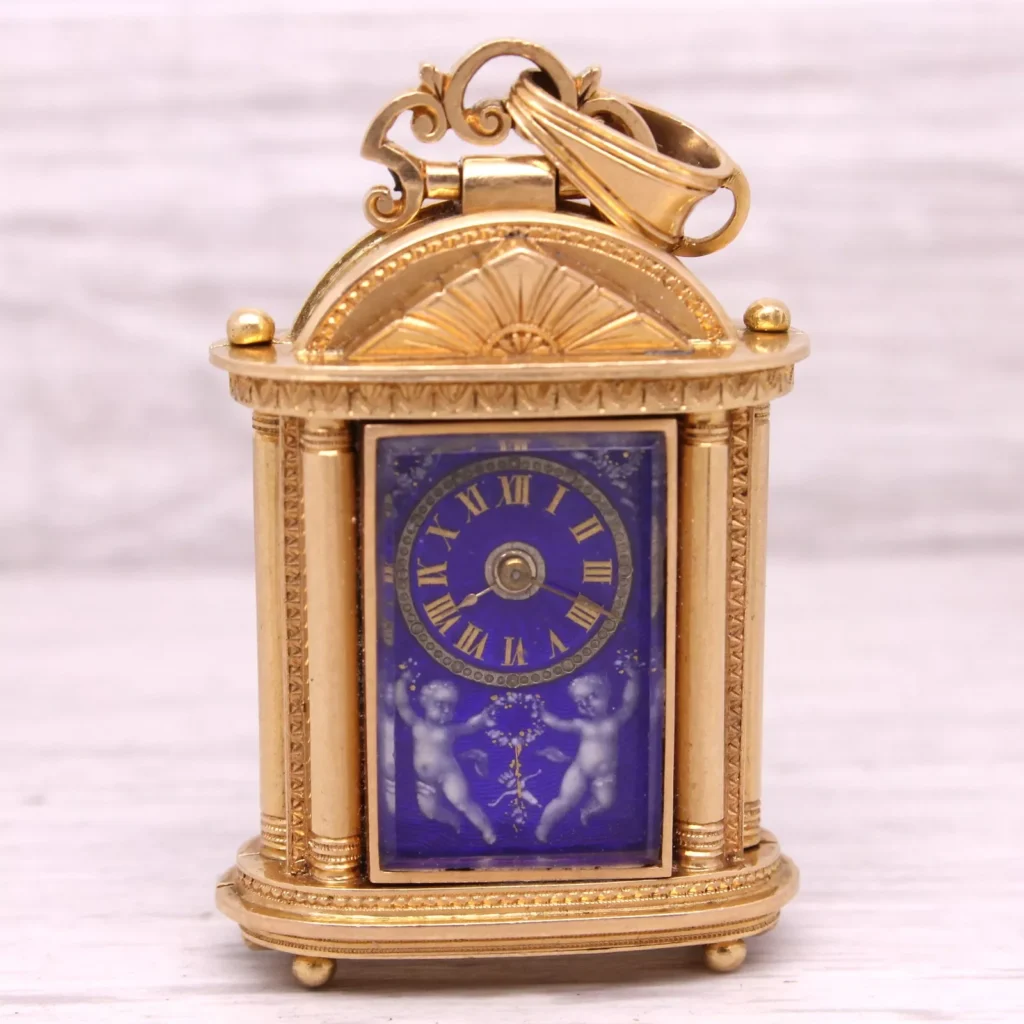
Crafted during a period when European watchmaking had reached unprecedented heights of miniaturization, this pendant watch demonstrates exceptional technical accomplishment. The 18k gold case, measuring a diminutive 28×36.5mm (excluding the bail), houses a fully functioning keywind movement—a testament to the remarkable skill of mid-19th century horologists who could create such precise mechanics on such a minute scale. The fact that this nearly 165-year-old mechanism continues to keep “decent time” speaks volumes about both the quality of its original construction and the care with which it has been preserved through generations.
What elevates this piece beyond mechanical marvel to artistic treasure is its exquisite blue enamel dial adorned with white relief cherubs. The enameling process was among the most challenging decorative techniques of the period, requiring multiple firings at precise temperatures to achieve the vibrant azure background against which the delicate cherub figures appear to float. This level of artistry was typically reserved for pieces commissioned by aristocracy or the emerging industrial elite of the mid-19th century.
The pendant’s provenance adds another layer of interest, with its accompanying note card from Marshall Field’s “Fields Afar” collection suggesting it passed through one of America’s most prestigious retailers. This connection to Marshall Field’s—known for curating exceptional international finds for its discerning clientele—hints at the piece’s recognized quality even in its earlier life as a vintage item.
The inclusion of the original winding key represents another remarkable aspect of this piece. These diminutive tools were frequently lost over the decades, making complete examples increasingly scarce. The presence of this key allows the new owner to engage with the timepiece exactly as its original owner would have done—opening the gold case, carefully winding the movement, and setting the hands in a ritual that connects them directly to the mid-Victorian era.
For collectors of fine timepieces, this pendant offers a particularly intriguing opportunity. While pocket watches from this period appear with some frequency in the market, pendant watches—especially those with such elaborate decoration and in working condition—are considerably rarer. The reference to a similar example selling at Antiquorum in 2006 provides valuable market context and suggests the piece’s investment potential alongside its aesthetic appeal.
Beyond its value to collectors, this pendant watch offers versatility as a wearable treasure. It could be suspended from a fine gold chain as originally intended, incorporated into contemporary jewelry designs as a spectacular focal element, or displayed in a cabinet of curiosities where its mechanical and artistic qualities can be fully appreciated.
The glass crystal remains in “nice condition,” an uncommonly fortunate circumstance for a piece of this age. These delicate coverings often suffered damage over the decades, and finding an example with its original crystal intact adds significantly to both the historical integrity and value of the piece.
For those drawn to the romanticism of the Victorian era, this pendant offers a tangible connection to a time when precision engineering and decorative arts achieved a harmonious balance. One can easily imagine this exquisite timekeeper adorning the neckline of a society lady at a grand ball, or carefully wound each morning as both jewelry and practical timepiece.
In an age of mass-produced accessories and disposable technology, this handcrafted marvel reminds us of a time when objects were created to last generations, combining beauty and function in equal measure. For the discerning collector who values historical significance, technical accomplishment, and sheer aesthetic delight, this miniature keywind pendant clock represents a rare opportunity to own a true horological jewel of the mid-19th century.
Golden Opulence: The “Collection De Art” Chiming Masterpiece in Gilt Metal Glory
In the world of decorative timepieces, few examples capture the bold aesthetic sensibilities of mid-century European design quite like this magnificent 8-day chiming table clock by “Collection De Art.” This substantial statement piece—weighing an impressive 11 pounds—marries functional precision with decorative grandeur in a way that exemplifies the luxurious design ethos of the 1950s and 60s.
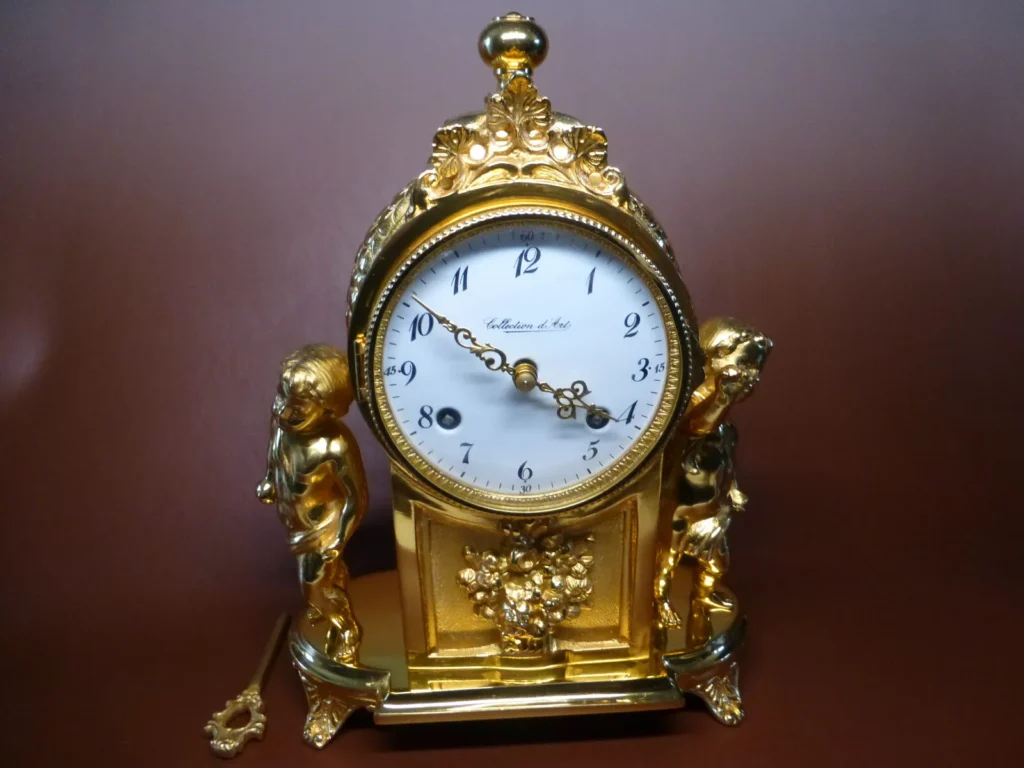
The clock’s most immediately striking feature is its opulent gold gilt metal case, crafted in Italy with the meticulous attention to detail for which Italian metalwork is renowned. The heavy gold overlay creates a radiant presence that commands attention in any setting, reflecting light from its intricately textured surface. Standing at approximately 8 inches wide, 11 inches high, and 4 inches thick, this timepiece possesses a substantial presence that balances between tabletop sculpture and functional clock.
What elevates this piece beyond mere decorative object is its sophisticated 8-day mechanical movement, which speaks to the technical expertise of mid-20th century European clockmaking. The seller’s note suggesting possible Swiss Bucherer origin adds a fascinating dimension to its provenance. Bucherer, established in 1888, has long been associated with precision timepieces of exceptional quality, and if this attribution is accurate, it places this clock within a distinguished horological lineage.
The chiming functionality represents another layer of mechanical sophistication. The clock’s hourly chimes provide not just time-telling utility but create periodic moments of auditory pleasure throughout the day. The additional half-hour chime—a thoughtful feature that enhances the clock’s practicality—demonstrates the maker’s understanding that a truly exceptional timepiece should engage multiple senses.
This clock’s journey—reportedly purchased at a Bucherer shop in Switzerland in the 1970s—adds a compelling narrative element to its appeal. This documented provenance, while incomplete, suggests the piece was recognized as a quality investment even at the time of its original retail sale. For collectors of decorative arts and timepieces, such glimpses of history enhance both the emotional connection to the object and potentially its investment value.
The recent professional servicing represents a significant advantage for potential buyers. Mechanical clocks of this age often require expert attention to restore proper functioning, and the seller’s confirmation that it has been “fully serviced and cleaned” suggests that the new owner will immediately enjoy both the visual splendor and mechanical reliability of this timepiece without the additional expense and inconvenience of immediate maintenance.
In terms of design versatility, this clock would make a spectacular focal point in a variety of interior settings. Its bold gilt finish would complement traditional spaces featuring antiques from earlier periods while also providing a striking contrast in more contemporary environments. The substantial size and weight ensure it would command attention whether placed on a mantelpiece, library table, or executive desk.
For collectors specifically interested in mid-century decorative arts, this piece represents an excellent example of the period’s fascination with combining traditional craftsmanship with bold, sometimes dramatic, aesthetic choices. The heavy gilt treatment exemplifies the mid-century appreciation for materials that conveyed luxury and permanence during a time of rapid cultural and technological change.
The inclusion of the original winding key—often lost over the decades—adds both practical functionality and collector appeal. This small but crucial accessory allows the new owner to engage with the clock as intended, participating in the ritual of maintenance that creates a personal connection to the timepiece.
For those drawn to horological treasures that combine mechanical precision with artistic presence, this “Collection De Art” creation offers an exceptional opportunity. Its combination of Italian craftsmanship, possible Swiss movement, and imposing aesthetic presence creates a compelling package that would enhance any collection of decorative timepieces or serve as a magnificent standalone statement piece in a discerning home.
We invite collectors and design enthusiasts to consider adding this golden marvel to their collection—a timepiece that not only marks the hours but does so with unmistakable mid-century European panache.
Vacheron Constantin Liberty Coin Watch: Where Numismatic History Meets Haute Horology
In the rarefied intersection of fine watchmaking and numismatic treasures lies this extraordinary Vacheron Constantin Twenty Dollars Liberty Coin Watch—a remarkable marriage of American monetary history and Swiss horological excellence. This exceptional timepiece, crafted in 18KT yellow gold with the original Liberty Double Eagle coin in 22KT gold, represents one of the most fascinating and collectible specialty watches from one of watchmaking’s most prestigious maisons.

The foundation of this extraordinary timepiece is the Twenty Dollar Liberty coin, also known as the Double Eagle—one of the most iconic American gold coins ever produced. These coins were minted between 1850 and 1907, designed by James B. Longacre with Liberty wearing a classical Greek headdress on the obverse and an American eagle on the reverse. Originally created during the California Gold Rush era, these coins have become legendary among numismatists, with many examples now residing in museums and distinguished private collections.
What Vacheron Constantin—Switzerland’s oldest continuously operating watchmaker—accomplished with this piece is nothing short of remarkable. The artisans of this esteemed manufacture transformed a historical coin into a functioning timepiece by ingeniously engineering a hinged case that preserves the coin’s integrity while housing a sophisticated mechanical movement within. This achievement represents a perfect symbiosis of respect for both numismatic heritage and horological innovation.
The overall presentation is one of restrained elegance. The 35mm diameter provides substantial presence on the wrist without overwhelming it—a perfect size that balances historical proportion with contemporary wearability. At 85.8 grams, the substantial weight reassures the wearer of its precious metal content and quality construction. The 7.5-inch length ensures comfortable wear for a variety of wrist sizes.
The hallmarks—18KT and 750—confirm the gold content of the case and bracelet, providing assurance of the precious metal quality while distinguishing it from the even purer 22KT gold of the original coin. This attention to detail in material selection exemplifies Vacheron Constantin’s uncompromising standards, ensuring that each element of the watch meets precisely the right specifications for its purpose.
The reference number #7814 indicates this is a recognized model within Vacheron Constantin’s production history rather than a one-off creation. This lineage connects the piece to a specific period in the manufacture’s creative evolution and potentially enhances its collectibility among Vacheron enthusiasts who seek complete representations of the brand’s historical output.
For collectors of fine timepieces, this watch offers multiple dimensions of value. Beyond its inherent precious metal content, it represents a convergence of historical significance from both American numismatic tradition and Swiss watchmaking heritage. Such combinations rarely appear on the market, particularly from a manufacture with the prestige and provenance of Vacheron Constantin.
The piece would make a spectacular addition to collections focused on unusual timepieces, coin watches, or Vacheron Constantin’s special productions. Its distinctive character would immediately distinguish it even among other fine watches, making it an inevitable conversation piece when worn or displayed.
For the investment-minded collector, this watch offers intriguing potential. Historical Vacheron Constantin pieces have shown strong appreciation over time, while numismatic gold coins have their own separate collectible value. When these two desirable elements converge in a single item, they often create a value proposition that exceeds the sum of the individual components.
Though the seller has categorized this as a “Rolling Ball Clock” and attributed it to “Liberty” rather than Vacheron Constantin in the item specifics (likely due to listing system limitations), the description clearly identifies this treasure for what it truly is—an exceptional piece from one of horology’s most distinguished houses.
For those fortunate enough to consider acquiring this magnificent timepiece, it offers not merely a method of telling time but a tangible connection to two rich traditions of craftsmanship spanning continents and centuries. We invite serious collectors to explore this rare opportunity to own a piece that embodies the pinnacle of both monetary and horological history—a golden treasure in every sense of the term.
Victorian Fretwork Majesty: The Architectural Clock That Transcends Time
In the realm of unusual timepieces, this antique Victorian fretwork house clock stands as a magnificent testament to the era’s fascination with elaborate decorative arts and functional sculpture. This remarkable piece, combining architectural whimsy with precise timekeeping, represents a stunning example of Victorian craftsmanship that has survived with its original finish intact.

The clock’s most immediately captivating feature is its extraordinary architectural form—a fully realized miniature Victorian house rendered in intricate fretwork. Standing an impressive 32 inches tall, with a width of 24¾ inches and length of 14¼ inches, this is no modest mantel piece but rather a substantial statement piece designed to command attention in a Victorian parlor. The scale suggests this was created for a home of considerable proportions, where it would have served as both timekeeper and conversation piece.
The preservation of the original surface finishes—stains and paints—adds immeasurable value to this piece. In an era when many antiques have been stripped, refinished, or “improved” by well-meaning but misguided caretakers, finding examples with their authentic patina intact becomes increasingly rare. These original surfaces connect us directly to the craftsmen who created the piece and preserve the authentic color palette and aesthetic sensibilities of the Victorian period.
The mechanical heart of this whimsical clock case is equally impressive. The 8-day key-wind movement represents the height of domestic clock technology for its era, requiring weekly rather than daily attention. This feature was considered a significant convenience in Victorian households and represented a more sophisticated and expensive mechanism than the 30-hour alternatives. The “huge chime” mentioned in the description suggests this clock was designed not merely to display time visually but to announce it throughout the home with authoritative sonic presence.
What makes this piece particularly intriguing is its hybrid nature—part architectural model, part functional timepiece, and part display cabinet. The seller’s note that it “would look great with figures or decorations” points to how such clocks often served multiple purposes in Victorian interiors. The open structure would have provided perfect display spaces for small collectibles, figurines, or personal mementos, allowing the owner to create personalized vignettes within the clock’s architectural framework.
The transparent nature of the fretwork design means this clock interacts with light in fascinating ways, casting intricate shadows that would shift throughout the day as sunlight moves across a room. This quality adds a dynamic dimension beyond mere timekeeping, transforming the clock into an evolving sculptural presence within its environment.
While the seller notes that “the little chandelier and the lower porch were added post production,” these modifications appear sympathetic to the original aesthetic and actually enhance the piece’s charm. The miniature chandelier, in particular, reinforces the dollhouse-like quality that makes these architectural clocks so appealing to collectors.
For period interior enthusiasts, this clock would make an extraordinary focal point in any Victorian-inspired setting. Its substantial size and elaborate detailing would allow it to serve as an anchor piece around which other decorative elements could be arranged. Equally, for those with more contemporary interiors, this clock would provide a spectacular contrast piece—its intricate Victorian elaboration standing in dramatic juxtaposition to cleaner modern lines.
The mechanical nature of the clock offers another layer of appeal in our digital age. The weekly ritual of winding creates a personal connection between timepiece and owner that automated clocks cannot replicate. The satisfying click of the key turning in the movement and the mechanical precision of the chimes provide sensory experiences increasingly rare in contemporary life.
For serious collectors of Victorian decorative arts, architectural models, or unusual timepieces, this fretwork house clock represents an exceptional opportunity. Its original finish, substantial size, and mechanical complexity combine to create a piece of remarkable historical integrity and aesthetic appeal. Such elaborate architectural clocks appear on the market with decreasing frequency, making this well-preserved example particularly desirable.
We invite connoisseurs of Victorian craftsmanship to consider adding this extraordinary timepiece to their collection—not merely as a functional clock but as a three-dimensional window into the artistic sensibilities and mechanical ingenuity of the Victorian era.
American Horological Rarity: The Munger & Benedict Hotchkiss Clock with Exposed Second Hand
Within the realm of early American clockmaking, few pieces capture the innovative spirit and craftsmanship of the nascent republic quite like this exceptional shelf clock from the workshop of Asa Munger and his associates. This particular example, dating from the 1820s, represents a fascinating transitional period in American horology when clockmakers were establishing distinctly American styles while still honoring European traditions.
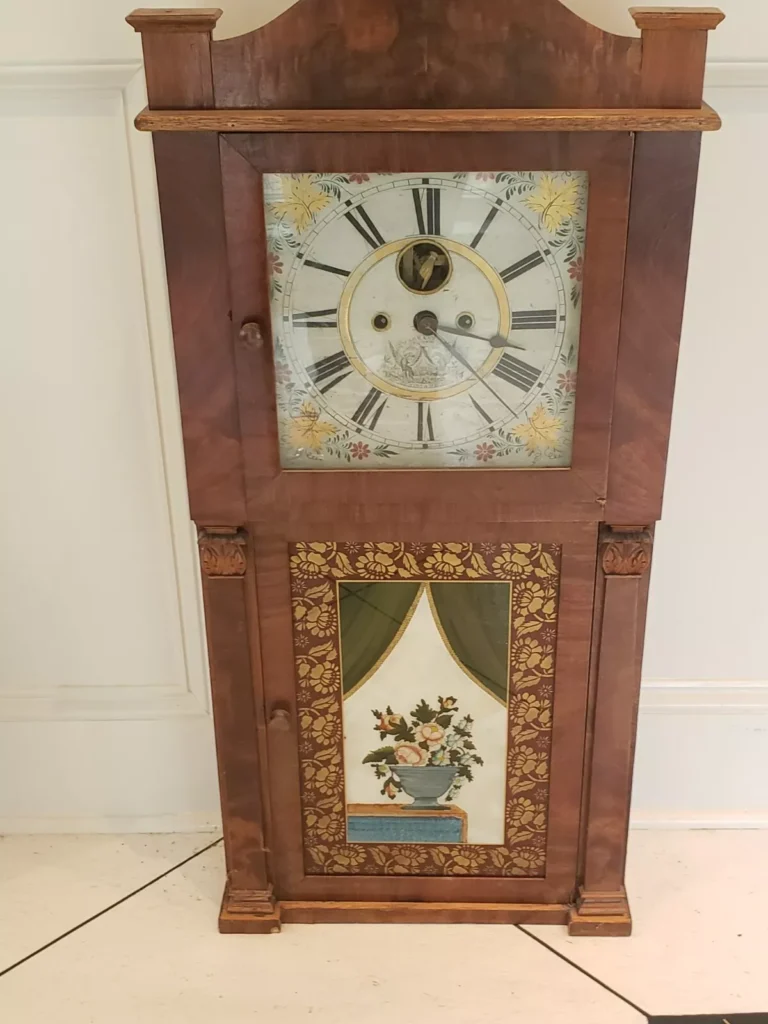
What immediately distinguishes this timepiece is its rare “exposed hand second” feature—an unusual technical display where the second hand opening is deliberately enlarged to reveal portions of the working mechanism beneath. This design choice reflects both technical confidence and artistic flair, allowing the owner to glimpse the intricate brass movement while also maintaining the clock’s functional elegance. For collectors of early American timepieces, this feature alone places the clock in a category of particular significance and rarity.
The case exemplifies the quintessential Munger style that had become standardized by the mid-1820s—featuring the characteristic large, flat-topped single door design with fully carved half-columns flanking the entryway. These architectural elements reflect the Federal period’s fascination with classical motifs, reimagined through a distinctly American lens. The interior, traditionally lined with “flamboyant wallpaper” in Munger clocks, would have provided a striking contrast to the more restrained exterior, revealing the clockmaker’s attention to details that would only be seen when interacting with the timepiece.
The original eagle pendulum preserved with this clock carries particular historical significance. These “flying eagle” pendulum bobs became a signature element of Munger’s work, reflecting both popular national symbolism in the young republic and possibly influenced by his family’s silversmithing background. The eagle, America’s national emblem, swinging steadily with each passing second, would have made a powerful patriotic statement in an early 19th-century American home.
Asa Munger himself stands as a fascinating figure in early American craftsmanship. Born in Massachusetts in 1778, his family history includes participation in defining American conflicts—his grandfather served in the French and Indian War, and his father fought in the Revolutionary War. This generational connection to the formation of the American identity perhaps influenced the distinctive American character evident in his clockworks. His training as both silversmith and clockmaker granted him versatility in metalworking that manifests in the fine detailing of his timepieces.
The “great label” mentioned by the seller is of particular importance to collectors. These square printed labels not only authenticate the piece but provide valuable historical documentation. In an era before mass production standardized products, these labels often contained information about the maker, location, and sometimes even specific instructions for the clock’s care—creating a direct link to the original maker’s intentions.
The partnership elements of this clock add another layer of historical interest. The Munger & Benedict collaboration (c.1818-1820) and the subsequent Hotchkiss & Benedict partnership represent the complex business relationships that characterized early American manufacturing. These associations allowed for knowledge sharing, resource pooling, and business expansion that helped establish American clockmaking as a competitive industry in its own right, eventually challenging European dominance in the field.
The heavy cast brass movement described as characteristic of Munger’s work speaks to the durability and quality that distinguished the finest American clocks of this period. These robust mechanisms were built to last generations—a promise this particular clock has clearly fulfilled as it approaches its bicentennial. The seller’s description of it as “near perfect” suggests remarkable preservation of both the case and the mechanism.
For the serious collector of early American decorative arts or horology, this clock represents a convergence of historical significance, technical innovation, and artistic design. Its connection to Asa Munger—whose work spans from simple shelf clocks to complex musical tall clocks with astronomical features—places it within a distinguished lineage of American craftsmanship.
Beyond its value as a collectible, this timepiece would serve as a magnificent focal point in settings ranging from period-accurate historical interiors to contemporary spaces where its distinctive American Federal aesthetic would provide dramatic historical contrast. Its association with Auburn, New York—a significant center of early American clockmaking—connects it to a specific regional tradition within the broader landscape of American decorative arts.
We invite connoisseurs of early American horology to consider this exceptional Munger & Benedict Hotchkiss shelf clock not merely as a timekeeper, but as a tangible connection to American craftsmanship during a formative period when the young nation was establishing its own distinctive artistic and manufacturing identity.
Italian Splendor: The Bronze Doré Inlaid Grandfather Clock of Regal Elegance
Within the rarefied world of exceptional timepieces, few examples command attention quite like this magnificent Italian bronze doré grandfather clock from the early 20th century. This extraordinary longcase clock transcends mere timekeeping to become a tour de force of decorative arts, combining exquisite metalwork, master woodworking, and precision horology in a harmonious symphony of craftsmanship.
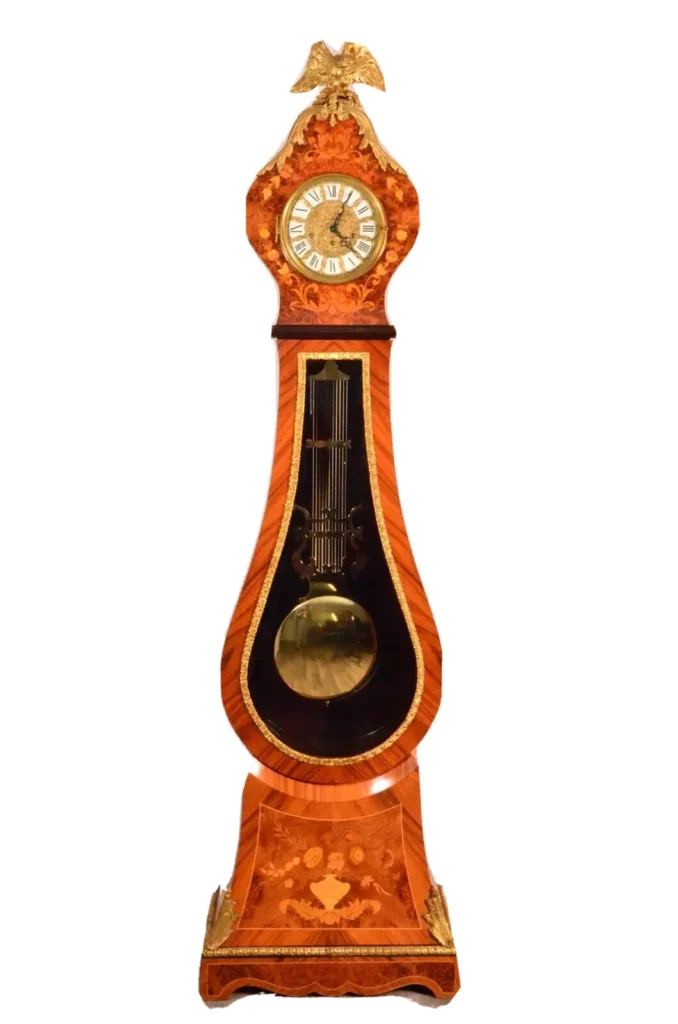
Standing an impressive 86 inches tall, this regal timepiece immediately announces its presence through the gilded bronze eagle that crowns its pediment—a powerful symbol of imperial authority that sets the tone for the clock’s overall aesthetic grandeur. This commanding bird of prey leads the eye downward to the scrolling acanthus leaf ornamentation that cascades along the case, executed in the rich bronze doré (mercury-gilded bronze) technique that was perfected by European craftsmen over centuries and reserved for only the finest decorative objects.
What distinguishes this clock beyond its metalwork is the exceptional wood marquetry that forms its case. The carefully selected bookmatched burl wood provides a sumptuous background for intricate floral inlays crafted from various exotic woods. This technique—requiring extraordinary precision and artistic vision—creates botanical designs that seem to bloom across the clock’s surface. Each inlay represents countless hours of meticulous craftsmanship, with artisans carefully cutting, shaping, and fitting minute pieces of contrasting woods to create these naturalistic designs.
The clock face itself continues this commitment to refined luxury, featuring hand-painted porcelain Roman numerals set against a gilded background. The three keyholes visible on the dial speak to the sophisticated Hermle movement contained within—a respected German mechanism known for reliability and precision. The Westminster chiming sequence, with its distinctive melodic progression, not only marks the passing hours but transforms timekeeping into a multisensory experience, with a special striking tune reserved for the important noon and midnight hours.
The lyre-shaped pendulum visible through the beveled glass door represents another thoughtful aesthetic choice. The lyre, associated with Apollo in classical mythology, connects this timepiece to centuries of artistic tradition while its steady, hypnotic motion creates a meditative focal point within the home. The curved convex glass door protecting the dial adds yet another dimension of craftsmanship, requiring specialized glass-forming techniques to achieve its perfect curvature.
Dating from between 1920 and 1949, this clock emerged during a fascinating period in European decorative arts when craftsmen were responding to the machine age by reasserting the value of traditional handcraftsmanship. The Renaissance styling mentioned in the listing reflects the ongoing influence of historical design languages in early 20th-century luxury goods, particularly in Italy where connections to classical and Renaissance heritage remained especially strong.
For collectors of fine timepieces, the clock’s Italian origin carries particular significance. While English and German clockmaking traditions have perhaps received more widespread recognition, Italian horology—especially when combined with the country’s decorative arts traditions—produced extraordinary pieces that often united technical precision with more exuberant aesthetic sensibilities than their northern European counterparts.
The exceptional preservation of this piece, with its working mechanism still chiming its Westminster sequence nearly a century after its creation, speaks to both the quality of its original construction and the care with which it has been maintained through generations. While professional servicing is recommended—as with any antique timepiece of this caliber—the fact that it remains in working order is remarkable and adds significantly to both its collectible and functional value.
Beyond its technical and artistic merits, this grandfather clock possesses the intangible quality of presence—the ability to transform any space it inhabits. At over seven feet tall with its gleaming bronze appointments and rich wooden case, it would serve as an instant focal point and conversation piece in settings ranging from traditional European-inspired interiors to contemporary spaces where its historical grandeur would create dramatic contrast.
For the serious collector of decorative arts or fine timepieces, this exceptional Italian creation represents an opportunity to acquire a museum-quality piece that exemplifies the highest standards of early 20th-century European craftsmanship. Its combination of bronze doré ornamentation, masterful wood inlay, and precision German movement creates a compelling package that would crown any collection of fine timepieces or European decorative arts.
We invite connoisseurs to consider adding this magnificent clock to their collection—not merely as a functional timekeeper but as a three-dimensional masterwork that captures the artistic sophistication and technical excellence of its era. In a world increasingly dominated by disposable goods, this grandfather clock stands as a testament to the enduring value of objects created with extraordinary skill and an unwavering commitment to beauty.
American Horological Icon: The Frank Herschede 9-Tube Dual Chime Grandfather Clock of 1917
In the pantheon of American clockmaking, few names command the respect and admiration accorded to Herschede. This spectacular 1917 tallcase clock, bearing the uncommon signature of “The Frank Herschede Co., Cincinnati,” represents not merely a timepiece but a pinnacle achievement from what many consider the golden age of American horology.

What immediately distinguishes this magnificent example is its 9-tube musical chime system—a sophisticated feature that elevates this clock from simple timekeeper to domestic concert master. The dual chime capability, offering both the familiar Westminster sequence and the more uncommon Whittington chime, provides the owner with a choice of melodic accompaniment to mark the passing hours. These original signed tubes produce tones of exceptional clarity and resonance, creating a sonic experience that cannot be replicated by modern mass-produced clocks with electronic chimes.
The self-adjusting, two-train movement—a hallmark of Herschede’s engineering excellence—bears serial number 5408, confirming its 1917 Cincinnati manufacture. This precise dating places the clock within an especially significant period in American clockmaking history. By 1917, the Herschede Clock Company had established itself as one of America’s premier manufacturers of high-grade clocks, and pieces from this era represent the perfect marriage of traditional craftsmanship with the precision manufacturing techniques that were revolutionizing American industry in the early 20th century.
Standing 76 inches tall, 25 inches wide, and 15 inches deep, this clock commands presence without overwhelming a space—ideal proportions that explain the enduring popularity of these American tallcase designs. The mahogany case exemplifies the clean, architectural approach to furniture design that characterized American interpretations of European styles during the early 20th century. While European grandfather clocks often featured more ornate decorative elements, this American example showcases a restrained elegance that emphasizes quality materials and proportional harmony.
The original adjustable pendulum represents another sophisticated feature of this exceptional timepiece. This innovation allowed for precise regulation of the clock’s timekeeping without requiring the services of a professional clockmaker for minor adjustments—a practical consideration that reflects the American approach to luxury goods that were meant to be not only beautiful but serviceable.
The inclusion of the original winding crank completes this clock’s exceptional state of preservation. These specialized tools were often misplaced over the decades, and finding an example with its matching crank intact adds significantly to both its historical integrity and practical usability.
For collectors of American decorative arts, this clock offers particular significance as a product of Cincinnati—a city that played a crucial role in America’s industrial and artistic development. The Frank Herschede Company represented American manufacturing excellence at a time when the nation was emerging as a global industrial power, and this clock stands as a tangible connection to that pivotal era in American history.
The fact that this century-old mechanism remains “in good working condition… keeping time and chiming correctly” speaks volumes about both the quality of its original manufacture and the care with which it has been maintained through generations. While all antique clocks benefit from regular professional service, the current functionality of this complex mechanism suggests remarkable engineering and materials that have stood the test of time.
Beyond its historical and mechanical significance, this Herschede grandfather clock offers practical advantages that explain the enduring appeal of these American masterpieces. Its dual chime capability provides variety over the decades of ownership. The self-adjusting movement minimizes maintenance concerns, while the timeless design aesthetic ensures it would complement interiors ranging from traditional to transitional.
For the serious collector of American clocks or decorative arts, this 1917 Herschede represents an exceptional opportunity to acquire a documented example from one of the nation’s most respected manufacturers during its prime production period. The combination of the uncommon Frank Herschede signature, nine-tube dual chime system, and excellent working condition creates a compelling package that would crown any collection of American timepieces.
We invite connoisseurs to consider adding this magnificent American tallcase clock to their collection—not merely as a functional timekeeper but as a cultural artifact that embodies the precision craftsmanship, practical innovation, and restrained elegance that characterized the finest American decorative arts of the early 20th century.
Timeless Investments: The Enduring Allure of Rare Antique Clocks
As we’ve explored these extraordinary timepieces, it becomes clear that collecting antique clocks is about acquiring more than mere timekeeping devices—it’s about preserving tangible pieces of artistry, innovation, and history. Each of these remarkable clocks tells a unique story that transcends centuries, connecting us to different eras, cultures, and traditions of craftsmanship.
From the exquisite Cartier Art Deco jade marvel of the 1920s to the German Black Forest cuckoo clock with its century of family heritage, these pieces demonstrate the incredible diversity within the world of horological treasures. The miniature 1860s gold keywind pendant clock reveals the Victorian fascination with mechanical miniaturization, while the Collection De Art gilt metal chiming masterpiece captures mid-century European opulence. The Vacheron Constantin Liberty coin watch marries numismatic history with Swiss watchmaking precision, and the Victorian fretwork house clock showcases architectural whimsy in functional form. The Munger & Benedict timepiece with its rare exposed second hand, the bronze doré inlaid Italian grandfather clock, and the Herschede 9-tube dual chime tallcase clock each represent pinnacles of their respective horological traditions.
What unites these diverse treasures is their exceptional craftsmanship, historical significance, and enduring appeal. Unlike many modern possessions designed for obsolescence, these antique clocks have proven their durability over decades—and in some cases, centuries. They continue to function as their creators intended, marking time with mechanical precision while simultaneously serving as spectacular decorative objects that enhance any interior.
For collectors and enthusiasts, these rare timepieces offer multiple dimensions of value. Beyond their aesthetic and mechanical appeal, they represent sound investments that have consistently appreciated over time. Their limited supply, combined with growing global interest in exceptional antiques, suggests their value will continue to increase as fewer museum-quality examples remain available to private collectors.
Whether your interest lies in European craftsmanship, American ingenuity, decorative artistry, or mechanical innovation, the world of antique clocks offers endless fascination. Each acquisition not only enhances a collection but also confers the privilege of stewardship—preserving these horological masterpieces for future generations to appreciate and enjoy.
We invite you to explore these timeless treasures further. The perfect antique clock awaits—ready to mark the hours in your home just as it has done for generations past, connecting you to the rich heritage of human creativity and technical brilliance that these remarkable timepieces embody.
